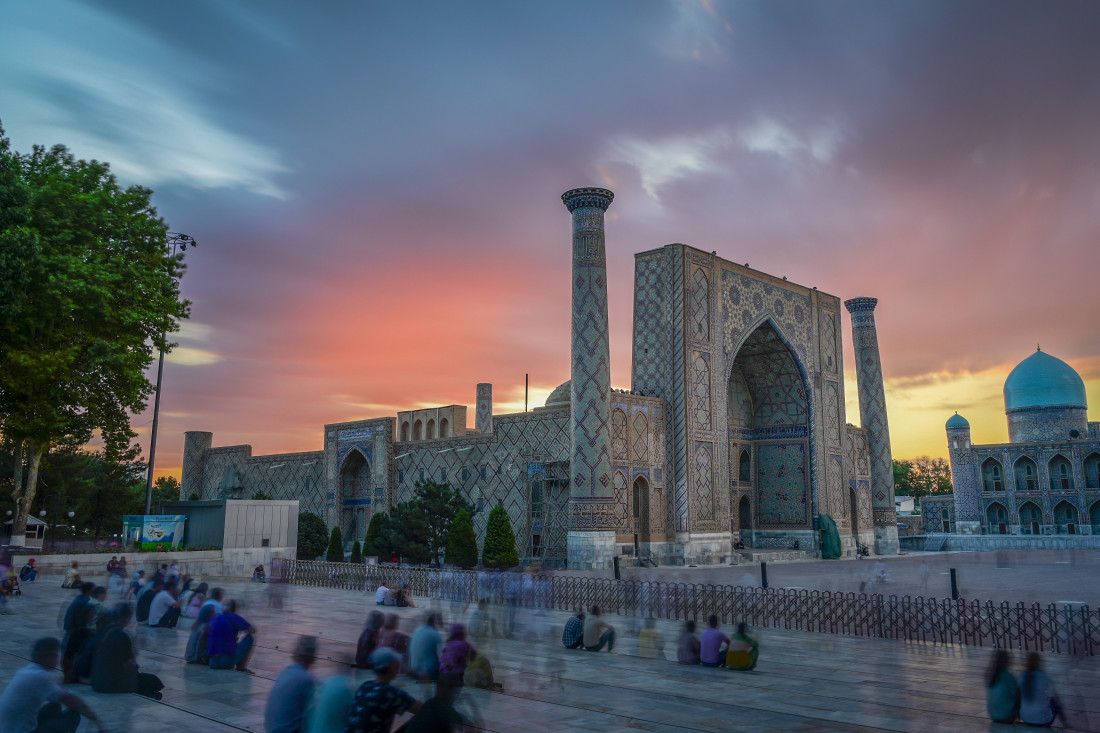In the middle of the XV century, Tamerlane’s grandson Mirzo Ulugbek (1409-1449) came to the throne in Samarkand. He was known to the world not only as a representative of the Temurids dynasty, but also as a prominent scientist and astronomer. He began the active construction of educational institutions in Bukhara, Samarkand, Shakhrisabz and Gijduvan. He was also the author of great Catalogue of Stars and builder of the ancient observatory in Samarkand.
Ulugbek madrasah in Samarkand is a classic example of higher educational institutions of the Muslim East.
The madrasah was built in 1417-1420. In artistic terms, it was not inferior to the buildings of Temur and at the same time significantly surpassed them in their strength.

Initially, the madrasah consisted of 50 hujras and trained more than a hundred students a year. According to the historians, Ulugbek himself taught in the madrasah. A prominent Persian poet, Jami, also lived and worked here. Among the most famous listeners of Jami in madrasah were Sheikh of Nakshbandi order - Khoja Akhror Vali and the great poet Alisher Navoi.
The building had 2 floors, four high domes over the corner auditoriums and four minarets at the corners. The giant portal, which occupies two-thirds of the main facade, faces the square with a huge and deep pointed arch.
Ulugbek madrassah suffered quite a lot during internecine wars in the XVIII century. The outer domes and most of the rooms on the second floor were destroyed.
Most of the restoration work was carried out in the early XX century by prominent engineers and architects of that time. In 1918, engineer M. F. Mauer drew up a project to temporarily strengthen the main minaret, and the aboveground part of the minaret’s plinth was also strengthened. For half a century courtyard facades were restored, the arch and external walls of the northern facade were relocated, courtyard aivans were strengthened, and a unique carved majolica mosaic in the madrasah portal was restored.
At the end of the last century, the repair and restoration works, timed to the 580-anniversary of Ulugbek, began at the madrasah. The project included a complete reconstruction of the second floor, restoration of architectural ceramics and replacement of destructive plasters and stalactites in the south-western premises.
Nowadays, Ulugbek madrasah, one of the three pearls of Registan, is a priceless decoration of the historical centre of Samarkand, included in the representative List of UNESCO World Heritage.
Working hours: 9:00 AM - 6:00 PM, Mon-Fri
For any questions
ПОЛЬЗОВАТЕЛЬСКОЕ СОГЛАШЕНИЕ
1. Определение
Настоящее Пользовательское соглашение (далее — Соглашение) является Публичной офертой в соответствии со статьёй 367 Гражданского кодекса Республики Узбекистан от 21.12.1995 (https://lex.uz/ru/docs/111181#162763) и регулирует порядок использования материалов и Сервисов сайта Государственного унитарного предприятия «Национальный PR-центр» (далее — Предприятие), размещённого на веб-сайте и поддоменах Национального Туристического Информационного Центра: https://uzbekistan.travel/ (далее — Сайт).
Посетитель и (или) Пользователь подтверждает, что ознакомлен, полностью и безоговорочно принимает все условия настоящего Соглашения и обязуется их соблюдать.
Использование Сайта Пользователем означает полное принятие данного Соглашения «как есть» в форме акцепта.
Соглашение вступает в силу с момента посещения любой страницы Сайта и (или) регистрации на Сайте и действует бессрочно во время пользования Сервисами Сайта.
Настоящее Соглашение обязательно для исполнения всеми Посетителями и Пользователями без каких-либо изъятий и дополнительных согласований.
Пользователь обязуется самостоятельно проверять актуальную редакцию Соглашения на Сайте перед использованием Сервисов.
2. Предмет Соглашения
Предметом настоящего Соглашения являются правила использования материалов Сайта и предоставление Посетителю и (или) Пользователю возможности использования Сервисов Сайта.
Предприятие является правообладателем исключительных прав на Сайт в целом и на его составные части, включая все виды контента: логотипы, товарные знаки, тексты, статьи, аннотации, иллюстрации, фотографии, графику, аудио- и видеофайлы, пользовательские интерфейсы, дизайн, структуру, программы, базы данных.
Я прочитал(а) и соглашаюсь с условиями использования сайта и политикой конфиденциальности.
